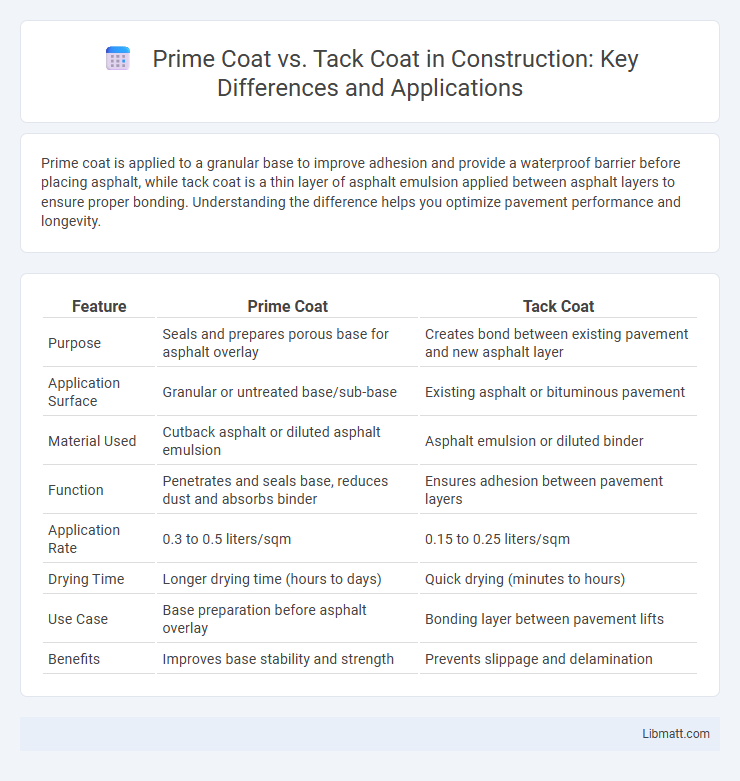Prime coat is applied to a granular base to improve adhesion and provide a waterproof barrier before placing asphalt, while tack coat is a thin layer of asphalt emulsion applied between asphalt layers to ensure proper bonding. Understanding the difference helps you optimize pavement performance and longevity.
Table of Comparison
| Feature | Prime Coat | Tack Coat |
|---|---|---|
| Purpose | Seals and prepares porous base for asphalt overlay | Creates bond between existing pavement and new asphalt layer |
| Application Surface | Granular or untreated base/sub-base | Existing asphalt or bituminous pavement |
| Material Used | Cutback asphalt or diluted asphalt emulsion | Asphalt emulsion or diluted binder |
| Function | Penetrates and seals base, reduces dust and absorbs binder | Ensures adhesion between pavement layers |
| Application Rate | 0.3 to 0.5 liters/sqm | 0.15 to 0.25 liters/sqm |
| Drying Time | Longer drying time (hours to days) | Quick drying (minutes to hours) |
| Use Case | Base preparation before asphalt overlay | Bonding layer between pavement lifts |
| Benefits | Improves base stability and strength | Prevents slippage and delamination |
Introduction to Prime Coat and Tack Coat
Prime coat is a low-viscosity material applied to a prepared base layer to enhance bonding and seal the surface, ensuring better adhesion for subsequent asphalt layers. Tack coat, usually a light application of asphalt emulsion, is applied between pavement layers to create a strong bond and prevent slippage. Understanding the distinct roles of prime coat and tack coat can optimize your pavement project's durability and overall performance.
Purpose and Function of Prime Coat
Prime coat acts as a foundational layer that enhances the bond between the existing surface and the subsequent asphalt layer by penetrating and stabilizing the substrate. It seals the underlying surface to reduce absorption of the binder, ensuring better adhesion and durability of the pavement structure. Your construction project benefits from a prime coat by improving the overall strength and longevity of the pavement system.
Purpose and Function of Tack Coat
Tack coat serves as a bonding agent applied between old and new pavement layers to ensure proper adhesion and prevent slippage or separation. Its primary function is to create a sticky surface that enhances the structural integrity and longevity of the overlay. You rely on a tack coat to improve pavement performance and reduce maintenance costs by promoting a strong interlayer bond.
Key Differences Between Prime Coat and Tack Coat
Prime coat is applied to a granular base layer to bind loose particles and create a stable surface before asphalt paving, while tack coat is a light asphalt emulsion sprayed on existing pavement to promote adhesion between old and new layers. The prime coat penetrates deeply to strengthen the base, whereas tack coat provides a sticky interface without significant penetration. Understanding these key differences ensures your pavement layers bond effectively for long-lasting durability.
Materials Used for Prime Coat and Tack Coat
Prime coat typically uses cutback asphalt or asphalt emulsions as its primary material, designed to penetrate and seal porous surfaces while enhancing adhesion for subsequent layers. Tack coat materials mainly consist of diluted asphalt emulsions or liquid asphalt binders, applied in a thin layer to promote bonding between existing pavement and new asphalt overlays. Understanding the specific materials used in your project's prime and tack coats ensures optimal pavement performance and longevity.
Application Methods for Prime Coat
Prime coat application methods typically involve spraying or spreading bituminous materials evenly over a prepared surface to penetrate and stabilize the base layer. Using a mechanical sprayer ensures uniform coverage, optimizing adhesion and moisture protection before subsequent pavement layers are added. Your choice of application method impacts the prime coat's effectiveness in enhancing surface durability and bonding.
Application Techniques for Tack Coat
Tack coat application involves spraying a thin, uniform layer of emulsified asphalt to ensure proper adhesion between existing pavement and a new asphalt layer. Specialized equipment, such as distributor trucks with calibrated spray nozzles, is used to apply the tack coat evenly at specified rates, typically between 0.02 to 0.10 gallons per square yard. Proper surface cleaning before application and accurate control of temperature and amount prevent slippage and ensure optimal bonding.
Importance of Prime and Tack Coats in Pavement Construction
Prime coats create a strong bond between the subgrade and the base layer, improving pavement durability by preventing moisture intrusion and enhancing adhesion. Tack coats provide a critical adhesive layer between pavement lifts, ensuring structural integrity and preventing slippage or shear failure under traffic loads. Understanding the roles of prime and tack coats helps you optimize pavement performance and extend the lifespan of your road infrastructure.
Common Issues and Troubleshooting
Prime coat issues commonly include uneven application and improper curing, leading to reduced adhesion and premature pavement failure. Tack coat problems often involve insufficient bonding due to contamination, incorrect application rate, or excess material causing slippage. To troubleshoot, inspect surface cleanliness, verify correct product selection, and ensure proper drying times for your pavement maintenance project.
Summary: Choosing Between Prime Coat and Tack Coat
Prime coat penetrates and seals the base layer, enhancing adhesion and providing a stable foundation for asphalt overlays. Tack coat creates a sticky surface that bonds new asphalt to existing pavement, ensuring layer cohesion without sealing the base. Your choice depends on whether you need to strengthen the base (prime coat) or improve layer adhesion between pavement courses (tack coat).
Prime coat vs tack coat Infographic

 libmatt.com
libmatt.com